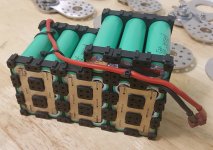Kepler
10 MW
cbr009 said:Hi John,
Borrowed a lipo battery from a friend so I could get everything set up.
I seem to only have one throttle setting, which I assume is 50%. I can toggle between throttle on and off ok, but it doesn't seem to change when I do a second 1.5 to 3 sec button push. When I first plugged in the battery, nothing seemed to work, but I think I must have done a 5 second push at some stage, because it then started working. But only one throttle level. Any thoughts?
Drive works really well, and such a light setup.
cheers,
Mick
Hi Mick I fully tested the button throttle and I know it will definitely give you 2 speeds. The difference is subtle though. Nothing like what you feel on a BBS02 powered bike. When you first start, count 1001, 1002 then release. That will be 50%. Then start from zero and count 4 seconds. You will feel the difference.


